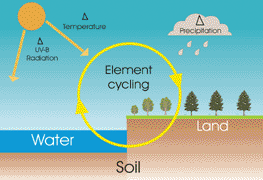The effects of ozone depletion on global biogeochemical cycles, via increased UV-B radiation at the Earth's surface, have continued to be documented over the past 4 years. In this report we also document various effects of UV-B that interact with global climate change because the detailed interactions between ozone depletion and climate change are central to the prediction and evaluation of future Earth environmental conditions.
There is increasing evidence that elevated UV-B has significant effects on the terrestrial biosphere with important implications for the cycling of carbon, nitrogen and other elements. Increased UV has been shown to induce carbon monoxide production from dead plant matter in terrestrial ecosystems, nitrogen oxide production from Arctic and Antarctic snowpacks, and halogenated substances from several terrestrial ecosystems. New studies on UV effects on the decomposition of dead leaf material confirm that these effects are complex and species-specific. Decomposition can be retarded, accelerated or remain unchanged. It has been difficult to relate effects of UV on decomposition rates to leaf litter chemistry, as this is very variable. However, new evidence shows UV effects on some fungi, bacterial communities and soil fauna that could play roles in decomposition and nutrient cycling. An important new result is that not only is nitrogen cycling in soils perturbed significantly by increased UV-B, but that these effects persist for over a decade. As nitrogen cycling is temperature dependent, this finding clearly links the impacts of ozone depletion to the ability of plants to use nitrogen in a warming global environment. There are many other potential interactions between UV and climate change impacts on terrestrial biogeochemical cycles that remain to be quantified.
There is also new evidence that UV-B strongly influences aquatic carbon, nitrogen, sulfur, and metals cycling that affect a wide range of life processes. UV-B accelerates the decomposition of colored dissolved organic matter (CDOM) entering the sea via terrestrial runoff, thus having important effects on oceanic carbon cycle dynamics. Since UV-B influences the distribution of CDOM, there is an impact of UV-B on estimates of oceanic productivity based on remote sensing of ocean color. Thus, oceanic productivity estimates based on remote sensing require estimates of CDOM distributions. Recent research shows that UV-B transforms dissolved organic matter to dissolved inorganic carbon and nitrogen, including carbon dioxide and ammonium and to organic substances that are either more or less readily available to micro-organisms. The extent of these transformations is correlated with loss of UV absorbance by the organic matter. Changes in aquatic primary productivity and decomposition due to climate-related changes in circulation and nutrient supply, which occur concurrently with increased UV-B exposure, have synergistic influences on the penetration of light into aquatic ecosystems. New research has confirmed that UV affects the biological availability of iron, copper and other trace metals in aquatic environments thus potentially affecting the growth of phytoplankton and other microorganisms that are involved in carbon and nitrogen cycling. There are several instances where UV-B modifies the air–sea exchange of trace gases that in turn alter atmospheric chemistry, including the carbon cycle.


 Please wait while we load your content...
Please wait while we load your content...